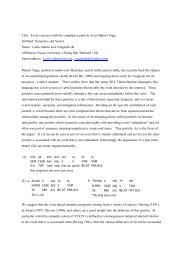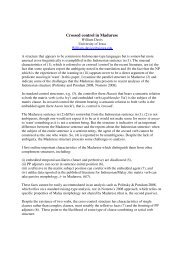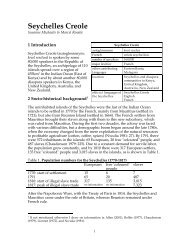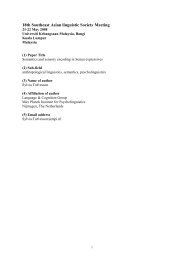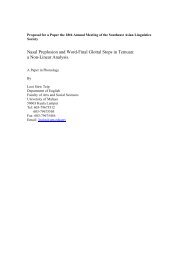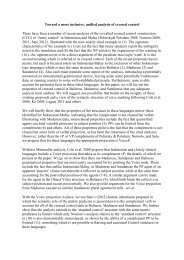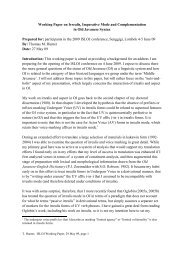Paper Title: Doing Metrosexuality in Men's Advertisements Sub-Field ...
Paper Title: Doing Metrosexuality in Men's Advertisements Sub-Field ...
Paper Title: Doing Metrosexuality in Men's Advertisements Sub-Field ...
You also want an ePaper? Increase the reach of your titles
YUMPU automatically turns print PDFs into web optimized ePapers that Google loves.
<strong>Paper</strong> <strong>Title</strong>: <strong>Do<strong>in</strong>g</strong> <strong>Metrosexuality</strong> <strong>in</strong> Men’s <strong>Advertisements</strong><br />
<strong>Sub</strong>-<strong>Field</strong>: Discourse Analysis and Sociol<strong>in</strong>guistics<br />
Name of Author: Korapat Pruekchaikul<br />
Affiliation of Author: English Department, Faculty of Arts, Chulalongkorn<br />
University<br />
E-Mail Address: kpruekchaikul@yahoo.com
Abstract<br />
<strong>Do<strong>in</strong>g</strong> <strong>Metrosexuality</strong> <strong>in</strong> Men’s <strong>Advertisements</strong><br />
Korapat Pruekchaikul<br />
Metrosexual is “a neologism generally applied to heterosexual men<br />
with a strong concern for his appearance (“Metrosexual”)” and those who<br />
have several lifestyles of typical gay men. Introduced for the first time <strong>in</strong> 1994<br />
<strong>in</strong> Mark Simpson’s article, “Here come the mirror men”, published <strong>in</strong> The<br />
Independent, the term achieves huge popularity when David Beckham, the<br />
British football player, appears as the metrosexual posterboy for many male<br />
advertisements and the model for “a glossy gay magaz<strong>in</strong>e <strong>in</strong> the UK (Simpson,<br />
2002)”. In the magaz<strong>in</strong>e, Beckham reiterated his gender identity that he is<br />
straight but does not m<strong>in</strong>d if not only women but men f<strong>in</strong>d him sexually<br />
attractive (Simpson, 2002).<br />
To possess the quality that both women and men admire, metrosexual<br />
men, as claimed by Simpson (2002), need to have money to spend, live with<strong>in</strong><br />
easy reach of a metropolis, embrace fem<strong>in</strong><strong>in</strong>ity more than ever before and<br />
accept female customs and attitudes which make them look uncerta<strong>in</strong> of<br />
their real identity. Moreover, be<strong>in</strong>g narcissistic is archetypal for metrosexual<br />
men as this quality confirms their actual existence among other people.<br />
If Mark Simpson’s article gives birth to the metrosexual man, some male<br />
advertisements, especially those concern<strong>in</strong>g health and beauty products,<br />
publicly confirm and ma<strong>in</strong>ta<strong>in</strong> the existence of this new male hybrid. The<br />
implication of metrosexuality <strong>in</strong> the advertisements is created <strong>in</strong> both<br />
language and paralanguage. In terms of language technique, the use of<br />
what Fairclough (1995) calls ‘conversationalisation (10)’ is predom<strong>in</strong>ant.<br />
Conversationalization, the mixture of public and private talk, can be so subtle<br />
that a scientific topic is presented <strong>in</strong> a relax<strong>in</strong>g way, “<strong>in</strong> terms of rhythm and<br />
<strong>in</strong>tonation, and … colloquial vocabulary and idioms (Litosseliti, 2006: 91)”, or <strong>in</strong><br />
terms of ‘role borrow<strong>in</strong>g (Torben and Schroder, 1985: 62)’. Also,<br />
conversationalization can be very sensational and attention-grabb<strong>in</strong>g,<br />
employ<strong>in</strong>g figurative languages like metonymy, hyperbole, pun, metaphor,<br />
parallelism and rhyme (Vestergard and Schroder, 1985: 59-62), or<br />
synaesthetic, supernym as well as catachresis (Guy, 1992: 104, 106, 108), as<br />
well as “sensational disclosures as headl<strong>in</strong>es, … direct questions, personal<br />
narratives and dramatic stories (Litosseliti, 2006: 91)”. Regard<strong>in</strong>g the<br />
paralanguage, there are many techniques used <strong>in</strong> advertisements. To name<br />
2
ut a few are iconity with words, connected icons and symbols, writ<strong>in</strong>g that<br />
provokes iconic behavior or idexical graphology (Guy, 1992: 78-85). Both the<br />
use of l<strong>in</strong>guistic and paral<strong>in</strong>guistic techniques mentioned earlier aim not only<br />
to sell the product advertised but also to generalize the type of metrosexual<br />
men – the men who both gays and straight guys “would rather be than [have<br />
sexual <strong>in</strong>tercourse with] (Simpson, 2002)”.<br />
This paper’s pr<strong>in</strong>cipal objective is to answer the question of how some<br />
male advertisements <strong>in</strong> Thailand represent and/or construct metrosexual Thai<br />
men as shaped and agreed upon by Mark Simpson (2002), Liu (“Mirror,<br />
Mirror”), and O’Shaughnessy and Stadler (2005: 364). The data of analysis<br />
comes from adverts <strong>in</strong> modern Thai male magaz<strong>in</strong>es, and the Internet. The<br />
answer to this question will enable us to realize the emergence of modern<br />
Thai males who are different from the normative men Thai people were<br />
familiar with <strong>in</strong> the past.<br />
Bibliography<br />
Cook, Guy. The Discourse of Advertis<strong>in</strong>g. (1992). London: Routledge.<br />
Fairclough, Norman. Media Discourse. (1995). London: Edward Arnold.<br />
Litosseliti, Lia. Gender and Language: Theory and Practice. (2006). London:<br />
Hodder Education.<br />
Liu, L<strong>in</strong>g. (n.d.). “Mirror, Mirror”. TIMEasia Magaz<strong>in</strong>e. Retrieved 7 November<br />
2007,from http://www.time.com/time/asia/covers/501051031/story.html.<br />
“Metrosexual”. (n.d.). Wikipedia. Retrieved 13 November 2007, from<br />
http://en.wikipedia.org/wiki/metrosexual.<br />
O’Shaughnessy, Michael and Stadler, Jane. Media and Society: an<br />
<strong>in</strong>troduction. (2005). 3 rd ed. Oxford: Oxford University Press.<br />
Simpson, Mark. (2002). “Meet the metrosexual”. Salon.com. Retrieved 11<br />
November 2007, from<br />
http://dir.salon.com/story/ent/feature/2002/07/22/metrosexual/<strong>in</strong>dex.html.<br />
Vestergard, Torben and Schroder, Kim. The Language of Advertis<strong>in</strong>g. (1985).<br />
Oxford: Basil Blackwell.<br />
3




